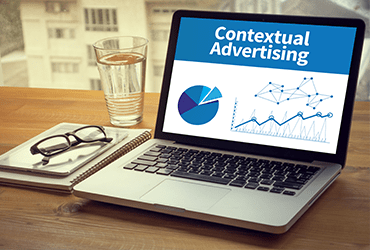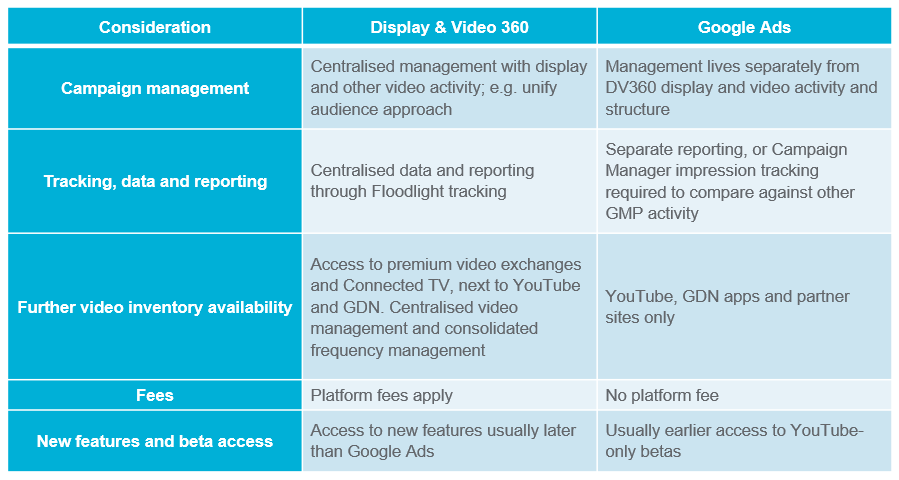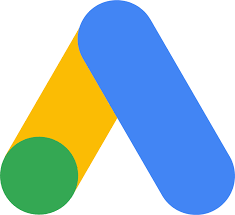
![]() Insights
Insights
Video advertising is becoming an increasingly important part of digital marketing strategies. Consumers want to see more video, and they also pay more attention than other forms of content. As a result, marketers are investing more in video than ever before; 96% of current video marketers are planning to increase or maintain their current spend.
When it comes to paid video, YouTube is an obvious choice. Not only do users head to YouTube specifically to watch videos, meaning they are more open to watching and engaging with video ads than on other platforms, but the platform also has over 2 billion monthly users.
Owned by Google, advertising on YouTube can be run on both of Google’s ad platforms: Google Ads and Display & Video 360.
Google Ads is Google’s standard (free) advertising platform, which is typically used for paid search activity but also offers display and YouTube advertising. Display & Video 360 is the Google Marketing Platform’s enterprise-level platform used for display, video, audio and more.
Both platforms are great tools and have their own advantages. There are a number of differences to consider when choosing which platform to run your YouTube advertising from; in this blog I will run through the key considerations.

When it comes to display ads, there are several differences between Google Ads and Display & Video 360 that make DV360 a better choice for large enterprises. For YouTube, the difference is less obvious as audience and bidding options are the same on both platforms.
If the majority of the video advertising you do is on YouTube, Google Ads is a great platform to be using (although in this case, we recommend running YouTube ads in a different account to your search ads, as combining the two can affect optimisation and reporting).
The benefit of switching your YouTube activity to DV360 becomes clear if you are running (or planning on running) display ads and further video activity. Not only does Display & Video 360 have access to a much bigger inventory than Google Ads, including premium publishers, but all activity run through DV360 uses Floodlight.
Having one central place to manage all your display and video activity (from audiences to bidding, to reporting) can be a huge benefit.

Display & Video 360 uses Floodlight to track YouTube activity, which is the same tracking used across all Google Marketing Platform products.
Running YouTube ads in DV360 allows for centralised data and reporting across all your display, video, and search activity to run through these products.
This also includes the de-duplication of conversions, which can build up a better picture of the impact of your YouTube ads are having during the wider customer journey.
You can also pull separate YouTube conversion reports which look at all conversions YouTube impacted; this data can be used to optimise your YouTube bidding strategy.
Both platforms use last-click attribution as standard; however, you can look at different attribution options for DV360 YouTube campaigns in Campaign Manager and DV360. One advantage Google Ads has over DV360 is access to data.
Google Ads shows all historical campaign data instantly within the interface, whereas DV360 instant reports only show the past three months. To get access to more data, you need to pull (and wait for) a more in-depth report.
Google Ads inventory is limited to the Google Display Network and YouTube, whereas Display & Video 360 has access to these plus hundreds of premium video exchanges and even Connected TV.
For brands that are investing more into video advertising, choosing DV360 allows you to expand your video activity beyond Google inventory and negotiate deals directly with top publishers and broadcasters.
By running all your video campaigns in DV360 (including YouTube), you also benefit from centralised video management and consolidated frequency management.

YouTube activity was traditionally designed to be run on Google Ads, and we still see access to new features happening earlier on Google Ads than DV360 – for example, lead generation ads are currently only widely available through Google Ads.
There is no set amount of time between a feature being released on Google Ads and becoming available on Display & Video 360, so it’s a case of either waiting patiently or running these types of ads on Google Ads while you wait.
As part of Google’s enterprise-level suite of tools, it costs businesses to run Display & Video 360. Platform and tracking fees are incorporated into the media spend budgets, and advertisers get complete transparency over how the cost is split.
Google Ads is Google’s free-to-use ad platform, so there are no platform fees involved. However, there is no visibility over any possible cost splits.
For brands who are just getting started with video, or are only running YouTube ads, Google Ads is a great tool; it’s free to use and offers excellent targeting, bidding and reporting capabilities.
For enterprises investing across video and display, the benefits of DV360 are invaluable. Being able to integrate your YouTube activity within a wider paid media strategy, from who you target to how you analyse results, helps to build a bigger picture of your customer journey.
Thinking of upgrading to Display & Video 360?We are a Google Marketing Platform Sales Partner

![]() Insights
Insights

![]() Insights
Insights

![]() Insights
Insights